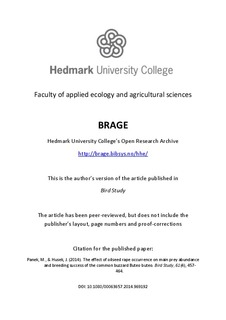The effect of oilseed rape occurrence on main prey abundance and breeding success of the Common Buzzard Buteo buteo
Journal article, Peer reviewed
Permanent lenke
http://hdl.handle.net/11250/277182Utgivelsesdato
2014Metadata
Vis full innførselSamlinger
Originalversjon
Panek, M., & Husek, J. (2014). The effect of oilseed rape occurrence on main prey abundance and breeding success of the common buzzard Buteo buteo. Bird Study, 61(4), 457-464. DOI: 10.1080/00063657.2014.969192 10.1080/00063657.2014.969192Sammendrag
Capsule The occurrence of oilseed rape increased main prey abundance and breeding success of Common Buzzards.
Aims We tested whether the occurrence of oilseed rape influences the abundance of Common Voles, i.e. the main prey of Common Buzzards and so also nesting activity and breeding success of Common Buzzards.
Methods The study was carried out in 2005–2012 in a 38 km2 area in western Poland, where oilseed rape plantations (12–106 ha) covered 18% of the agricultural land. The number of active burrow entrances was used as an index of vole abundance in various crops, and Buzzard breeding performance, i.e. the occurrence of annual nesting attempts in individual long-term nesting sites as well as the presence and number of fledglings, was estimated by observations of their nests.
Results The index of vole abundance was highest in oilseed rape, and judging by the proportion of active burrow entrances (33–77%), the plantations of rape typically supported a larger portion of the local vole population than other crops. The acreage of oilseed rape fields around individual nesting sites of Buzzards did not affect the probability of nesting attempts in these sites. However, the probability of successful nesting and the number of fledglings per successful nest increased with the area of oilseed rape around the Buzzard nesting sites.
Conclusion The occurrence of oilseed rape may positively affect prey availability and in turn the breeding success of Buzzards. The spread of oilseed rape may therefore also be beneficial for other vole-eating raptors hunting in the agricultural landscapes.
